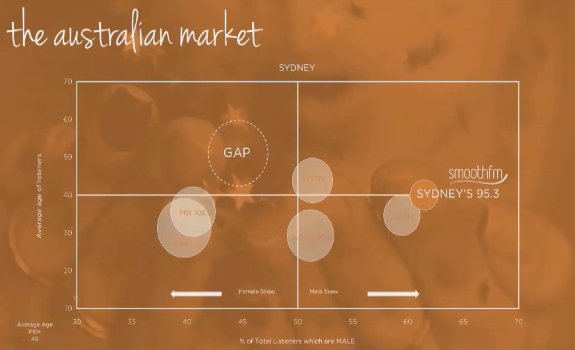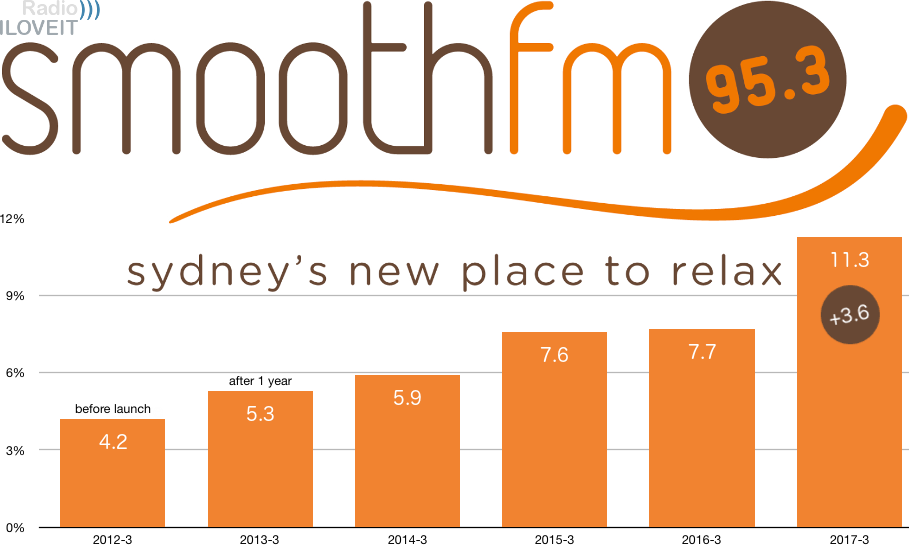How to build a new station in a competitive radio market? This case study of Australia’s smoothfm is teaching good lessons for every launch team.
Australia’s NOVA Entertainment is mostly known for its CHR brand NOVA, but is now even more successful through their Soft AC format smoothfm with FM frequencies in Sydney and Melbourne, and DAB+ coverage in Brisbane, Adelaide and Perth. Marketing director Tony Thomas shared at Radiodays Europe 2017 how they succeeded to introduce a new brand in a crowded marketplace by answering unfulfilled needs and creating positive images.
“It was not a format launch”

smoothfm’s brand concept is based on emotional positioning (image: NOVA Entertainment)
Find your market gap
Owner Lachlan Murdoch (indeed, son of media entrepreneur Rupert Murdoch) had a good reason to pop champagne recently, when GfK Australia presented their radio audience measurement report for Survey 3, 2017, according to which smoothfm is now the #1 music radio station (and #1 FM radio station) in Sydney with a market share of 11.3% (up 1.4%), right after heritage AM talker 2GB (11.4% share, down 0.2%). Looking at the Australian radio ratings archive, it’s evident that smoothfm’s ratings have been rocket fueled lately. A year ago (Survey 3, 2016), smoothfm’s share in Sydney was 7.7%. Now, again, 11.3%. In Melbourne, they’ve jumped from 7.4 to 9.3% (up 1.9%) compared to this time last year.
The new station’s launch on May 21, 2012, meant a format flip from Classic Rock (on what used to be Sydney’s 95.3) to Soft Adult Contemporary, based on research. The company (then named dmg Radio Australia) decided to do a market study to find the best music format. The result showed an opportunity amongst 35-54 year-old females, which Tony Thomas calls “a very attractive market to go after” as “there’s a lot of them, and they spend a lot of money”. That part of the Australian radio audience wasn’t being served back then, as the Australian radio market in late 2011 was dominated by CHR, and male-oriented formats like Rock. “There was this huge opportunity.”
Bridge your format change
The history of smoothfm’s two current FM frequencies starts in 2004, with a station called Vega that offered a mix of both music and talk that was unsuccessful. In 2009, Vega was rebranded into Classic Rock, but that station was insignificant in terms of ratings as well. “It was languishing in the 3s, which, in Australia, puts you in the ‘irrelevant pile’ pretty much.” In early 2011, a strategy was formed to turn things around, but in a way that would not alert competitors of their plans.
Instead of immediately launching a new brand, it was chosen to put the existing stations on hold first. “We turned them into jukeboxes called 95.3 and 91.5, and effectively let them run on autopilot.” A task force of 10 people — no one else knew about the new strategy — was formed, and over the course of 2011, they “slowly evolved the bridging station” step by step towards the new format, so it would not be something completely new to listeners.
Determine your (emotional) USP
Keeping their female audience in mind, they built the station on a feeling. “It was not a format launch. We developed an emotional position”, the marketing director says about smoothfm’s ‘relax’ benchmark. “That gave us a really clear filter for everything. One of the most important things that have driven the success of the station is a very strong and clear strategy. That clarity around the strategy produces a really strong and consistent execution opportunity.”
They went out to interview radio listeners from the target demo. Those conversations with 35-54 year-old women in Sydney and Melbourne made clear what went on in their lives, and what they were looking for. “The consistent thing that came out was this busyness. Their lives are busy, and there’s a lot of noise in formats that were being presented to them in the market; a lot of CHRs.” Therefore, it was chosen to let smoothfm be ‘your easy place to relax’.
“That’s what made the ad”
Michael Bublé shows some self-deprecating humour in this TV spot (video: NOVA Entertainment)
Maintain your brand promise
Apart from some playlist tweaks, Thomas considers their brand to be really consistent. “It’s the same station that we launched five years ago.” He thinks it’s a very efficient concept as well. “It’s got huge margins. We haven’t got overpriced breakfast show hosts; it’s a station that is very profitable, and very unique in the Australian market, which is generally loaded with very expensive talent.” Another benefit is the format potential, as “the station has seen enormous growth over the last five years by top and bottom line; there’s huge growth in the market amongst that demo.”
Make your format appealing
When developing smoothfm’s brand values, the launch team had a task to establish pride in people’s choice of a Soft Adult Contemporary format. “It’s really easy for a Soft AC, based on the music playlist, to be perceived as daggy and old. Therefore, we had to build an aspirational brand that had a level of sizzle.” While their core audience is 35-54 years, they wanted to be be attractive for a broad(er) cume to take the station to number 1. To introduce the brand to all of these people, the strategy was to offer as many occasions to sample the format as possible. He doesn’t specify how they did that exactly. It might have been a combination of on-air promotion and off-air marketing.
Leverage your core artists
To give the launch an attention grabber, they approached Michael Bublé through Warner Music. “His music was a perfect fit for the station playlist, and his character and personality were appealing. The footage was shot in LA, involving a woman who comes home, exhausted from a long day. She turns on the radio, tuned to smoothfm, and closes her eyes. Then, Bublé sits down next to her, and begins to sing. “I presented an idea to him on the set where she opens her eyes, and is absolutely blown away. He goes: na, na, na; I want her to tell me to shut up. That’s what made the ad.” Bublé also officially launched smoothfm during the More Music Breakfast Show with Ed Phillips on May 21, 2012 at 7am:
“It’s a very distinct sound”

Tony Thomas explains their playlist is designed to reflect a certain mood (image: Radiodays Europe)
Market your (weekend) talent
Contrary to stations who focus their high-profile personalities on weekdays, smoothfm likes to combine a weekday schedule of experienced radio professionals with a weekend line-up of well-known media personalities, such as TV stars hosting a weekend slot. It provides opportunities to create “some profile and buzz”. Furthermore, smoothfm has a weekend slot with rotating artists, hosting a show. Stars like Elton John, Olivia Newton-John, Lionel Richie, Dolly Parton and James Blunt play music and tell stories. Tony Thomas sees it as another way to profile the station.
Daypart your music format
Under content director Paul Jackson, who’s programmed UK stations like Capital, Radio X and Virgin Radio, smoothfm’s playlist has been built around a certain feeling, rather than a specific genre. “Everything is crafted together to provide a different feel at different points of the day. It’s a very distinct sound; very unique in the Australian market.” Key artists include Adele, Bruno Mars, Billy Joel, Mariah Carey, Neil Diamond, Sam Smith, Elton John, and of course Michael Bublé.
Take your brand further
While their core product is still radio, smoothfm aspires to be more than a station. “When you’re developing a brand that primarily exists on air, it’s really important to bring it out to people; let them experience it.” NOVA Entertainment is evolving smoothfm into a 360° brand with on air, on screen, online, streaming, experiential, social, events, and music. Some of these extensions not only offer cross-promotion possibilities, but also new revenue potential (see part 2).
Header image: NOVA Entertainment, Thomas Giger







This is a very good example, and a well-written explanation.
Identifying a market niche is a complex process with ultimate return.
Rethink your current practice, and “research, research, research”!
Cheers,
A